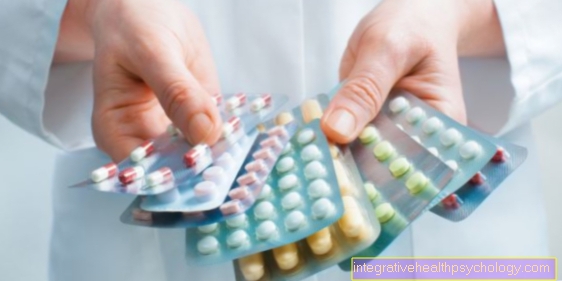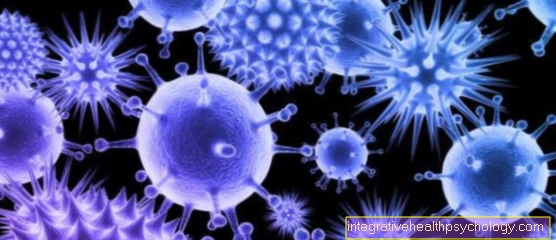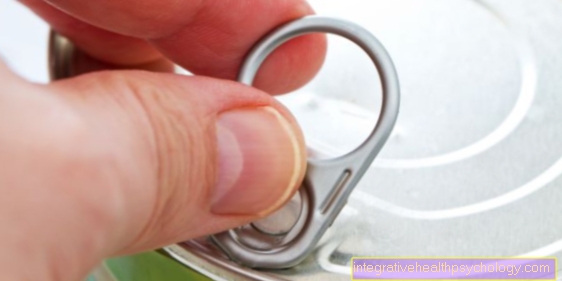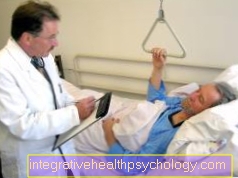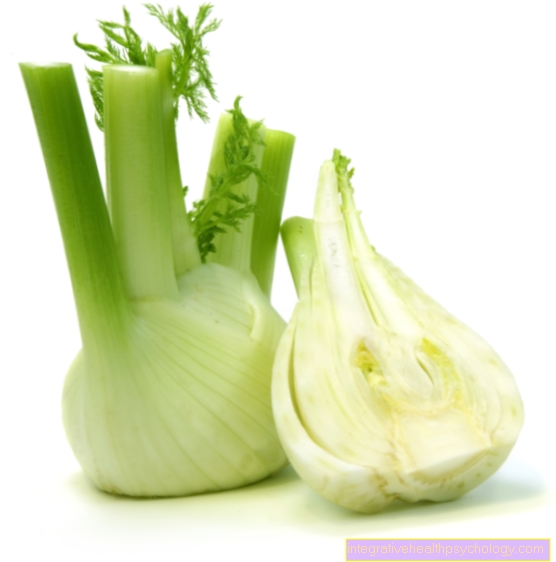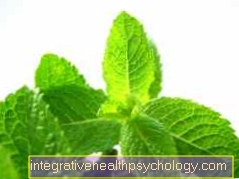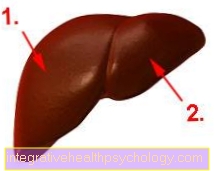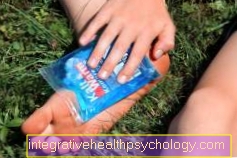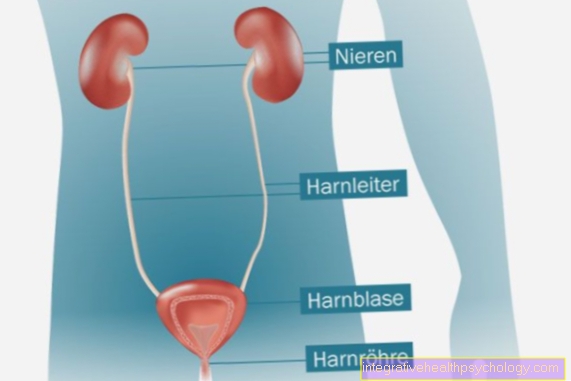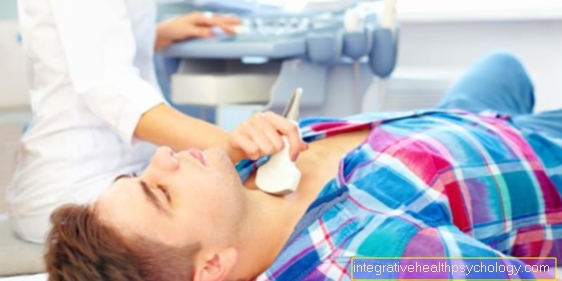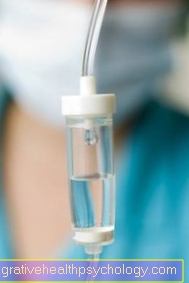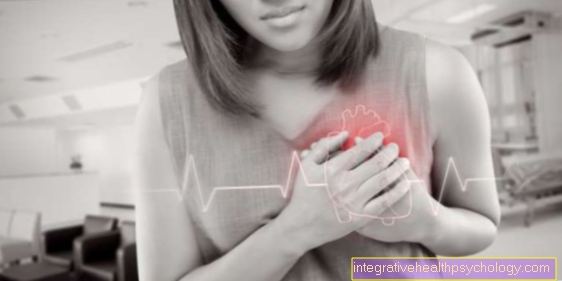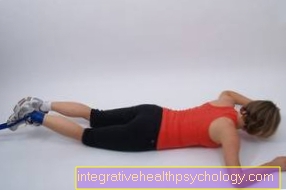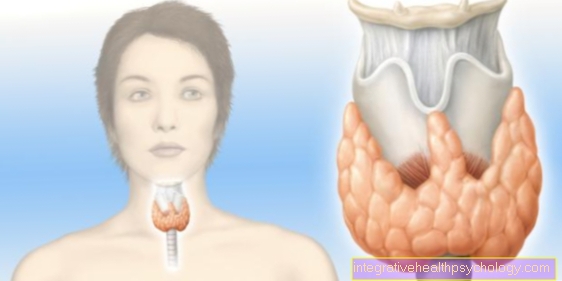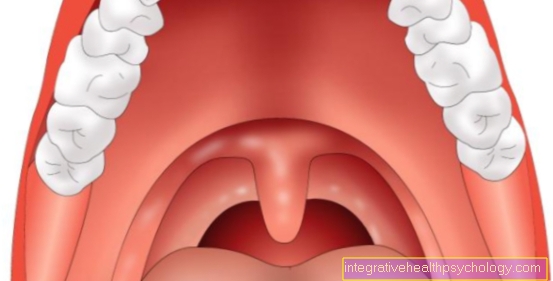Palpitations after eating
introduction
Heart stumbling is a form of arrhythmia. In technical jargon, extrasystoles are mentioned. These are additional heart beats that do not correspond to the normal heart rhythm.
The cause are complex false impulses in the conduction system of the heart. Palpitations can occur more frequently after eating.
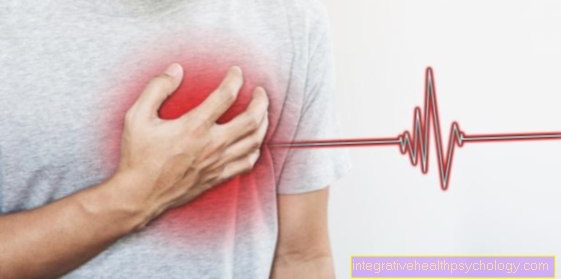
Causes of palpitations after eating
If heart stumbling occurs more often after eating, it can be the so-called Roemheld syndrome. This is a complex of symptoms that is related to excessive food intake or the ingestion of foods that cause gas.
The amount of food or gas formation pushes the diaphragm upwards towards the heart. This pressure on the heart can cause various complaints, including heart palpitations.
Occasionally, palpitations can also occur after eating, for example, if foods containing caffeine (tiramisu, espresso after a meal) have been consumed. Caffeine activates the cardiovascular system and is suspected to occasionally trigger heart palpitations.
For detailed information on the causes of heart palpitations, see: Causes of palpitations
Thyroid dysfunction
Thyroid dysfunction can cause heart palpitations. In particular, if the thyroid is overactive, extrasystoles can occur. Palpitations that occur after eating are independent of thyroid disorders.
However, heart stumbling can occur both as a result of thyroid disease and more often after meals. So one does not exclude the other.
For more information on thyroid dysfunction, see:
- Heart stumbling through the thyroid gland
- Symptoms of an overactive thyroid
Diagnosing palpitations after eating
To make a diagnosis, the precise history is crucial. In addition, the stumbling of the heart must be shown with the help of an EKG to be sure that it is extrasystoles and not more serious cardiac arrhythmias.
In most cases, a simple EKG is not enough to detect extrasystoles, as these do not occur constantly and an EKG only records the heart's action for about 10 seconds. A 24-hour EKG lead increases the likelihood of being able to record the palpitations. In addition, it has the advantage that it also covers the phase after eating due to the recording over 24 hours. This is critical if the palpitations occur primarily after eating.
Further examinations may follow to rule out diseases of the heart such as calcification of the coronary arteries (coronary artery disease) or cardiomyopathy or other diseases such as thyroid dysfunction. Investigations such as cardiac ultrasound (echocardiography), stress ECG (ergometry) and blood tests come into question.
If Roemheld syndrome is present, it can be helpful to rule out food intolerances such as lactose or fructose intolerance.
Read more about this in the next article: Exercise ECG
I can tell from this that this is dangerous
Stumbling the heart is rarely dangerous, even if it often feels unsettling for those affected when the heart loses its beat. Especially if heart stumbling occurs regularly after large or very gasping meals, this is an indication that no dangerous heart disease is the cause.
However, if the palpitations lead to symptoms such as shortness of breath or dizziness, a doctor should be consulted. This can then decide whether a more precise diagnosis is necessary.
When do I have to see a doctor?
In most cases, palpitations after eating are not a reason to see a doctor. Heart stumbling occurs very often in young, completely healthy people.
However, if the palpitations lead to symptoms such as dizziness or shortness of breath and these symptoms recur, a doctor should be consulted for further clarification. A doctor should always be consulted immediately if there are symptoms such as a feeling of pressure on the chest or radiating pain in the neck, jaw or left arm.
Other accompanying symptoms
Heart stumbling that occurs after eating can be the so-called Roemheld syndrome, which occurs especially after large meals or extremely flatulent foods.
In addition to palpitations, symptoms such as:
- Racing heart (tachycardia),
- significant slowing of the heartbeat (bradycardia),
- Shortness of breath in the sense of shortness of breath (dyspnoea),
- Difficulty swallowing (dysphagia)
- Hot flashes,
- Anxiety,
- Dizziness,
- Sensation of pressure in the chest, which may be wrongly interpreted as a symptom of a heart attack.
Treating palpitations after eating
Treatment for palpitations after eating depends on the cause. If Roemheld Syndrome is believed to be causative, then changing your diet is the key to success. Opulent meals should be avoided. It is better to take several small meals spread out over the course of the day. In addition, flatulent foods should be avoided.
It can be useful to test beforehand which foods are particularly causing the symptoms.Flatulent foods include types of cabbage such as Brussels sprouts, white cabbage, savoy cabbage or cauliflower, legumes such as peas, beans or lentils, unripe fruit, dairy products such as whole milk and various types of cheese (camembert, mountain cheese, gorgonzola and very fatty cheeses), onions and whole grain products such as certain types of bread (especially fresh bread) and muesli. Even very high-fat foods stimulate gas production in the intestines and can lead to a bloated stomach.
If there are food intolerances, such as lactose or fructose intolerance, the corresponding foods should be avoided. Carbonated beverages should be avoided, alcohol should only be consumed in small quantities.
In addition, sufficient physical activity must be ensured. If you are overweight, this should be reduced if possible.
You can also take advantage of the exfoliating effects of various types of tea, such as caraway, anise and fennel tea.
There are also various drugs available over the counter in pharmacies that contain the active ingredient Dimeticon contain. This also reduces the accumulation of air in the gastrointestinal tract and has an anti-inflating effect. Examples are here Sab Simplex® or Espumisan® to be mentioned as preparations.
You can read more detailed information on this topic here: Therapy for heart palpitations
Homeopathy for palpitations
There are several homeopathic approaches to treating palpitations after eating.
On the one hand, globules can be taken against heart stumbling. These include:
- Adonis vernalis
- Cactus
- Ammonium carbonicum
- Lycopus virginicus.
But homeopathic remedies for flatulence can also be tried - if Roemheld syndrome is present. For example:
- Acidum nitricum
- aloe
- Carbo vegetabilis
- Chamomilla
- Nux vomica
- Pulsatilla
In general, there is no proof of effectiveness for homeopathic remedies. In addition, the range of means that can potentially be used is very wide. The means mentioned here are only a small selection.
For more information on this topic, see: Homeopathy for flatulence
Duration of palpitations
In acute situations, heart palpitations usually only last for a short time. In some people, only 1-2 beats occur outside of normal heart rhythm. For others, the palpitations drag on for a few minutes. However, it usually does not last longer than a few minutes.
forecast
Palpitations after eating can occur again and again, especially if the triggering factors such as fatty, flatulent foods that trigger their occurrence are not avoided. The prognosis is good, cardiac stumbling after eating does not have a significant impact on life expectancy.
Course of disease
Palpitations after eating can occur once but also recurring. Avoiding known triggers (flatulence, fatty foods, rich meals) can often reduce the likelihood of occurrence.
Most people experience heart palpitations at irregular intervals. For some, however, it only occurs in certain life situations and can then also be caused by stress.
Recommendation from the editorial team:
- Palpitations at night
- Therapy of heart stumbling
- Heart palpitations - how dangerous is it?


